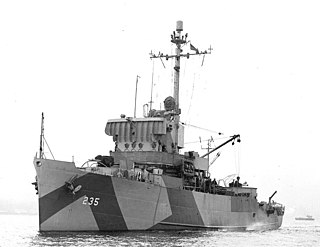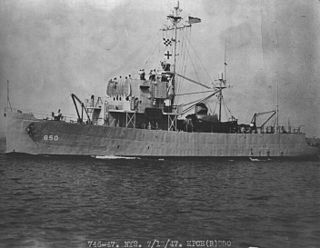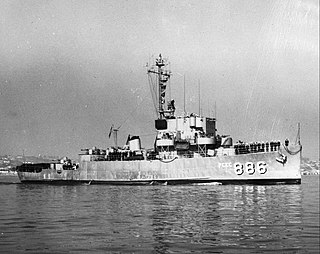
USS Dyess (DD/DDR-880), a Gearing-class destroyer, was a ship of the United States Navy named for Aquilla James Dyess (1909–1944). Dyess was awarded the Medal of Honor posthumously for his leadership of his battalion of Marines in the Battle of Kwajalein. The ship was laid down by Consolidated Steel Corporation at Orange, Texas on 17 August 1944, launched on 26 January 1945 and commissioned on 21 May 1945. The vessel spent the majority of her career patrolling the Mediterranean Sea with NATO forces. The ship was decommissioned on 27 January 1981 and sold to Greece the same year for spare parts.
Three ships of the United States Navy have been named USS Gettysburg for the Battle of Gettysburg.
USS Execute (AM-232) was an Admirable-class minesweeper built for the United States Navy during World War II. She was originally ordered and laid down as USS PCE-905, the lead ship of the PCE-905 class of patrol craft. She was reclassified as an Admirable-class minesweeper by the time of her June 1944 launch, and named Execute by the time of her November 1944 commissioning. After service in the Pacific during World War II, she was decommissioned in August 1946 and placed in reserve. While she remained in reserve, Execute was reclassified as MSF-232 in February 1955 but never reactivated. In 1962, she was sold to the Mexican Navy and renamed ARM DM-03. In 1994, she was renamed ARM General Juan N. Méndez (C51). She was stricken in July 2001, but her ultimate fate is not reported in secondary sources.

USS Ampere (PCE-919/AM-359/YDG-11/ADG-11) was originally planned as a PCE-905-class patrol craft for the United States Navy, PCE-919, and laid down as an Admirable-class minesweeper, named Drake, for the male duck. Before she was commissioned, her name was cancelled and she was reclassified as a District Degaussing Vessel. She was later renamed Ampere, after the ampere, a unit of electric current, which takes its name from the French physicist André-Marie Ampère.
USS Buttress (PCE-878/ACM-4) was an auxiliary minelayer (ACM) in the United States Navy during World War II. This ship and USS Monadnock (ACM-10) were the only ACMs not previously U.S. Army mineplanters.
USS Facility (AM-233) was an Admirable-class minesweeper built for the United States Navy during World War II. The ship was ordered and laid down as PCE-905-class patrol craft USS PCE-906 but was renamed and reclassified before her June 1944 launch as Facility (AM-233). After earning three battle stars for service in the Pacific during World War II, she was decommissioned in September 1946 and placed in reserve. While in reserve, Facility was reclassified as MSF-233 in February 1955 but never reactivated. In October 1962, she was sold to the Mexican Navy and renamed ARM DM-04. Her ultimate fate is not reported in secondary sources; she may have been out of service by April 1973 when another member of the Admirable class was acquired by the Mexican Navy and given the name DM-04.

USS Fixity (AM-235) was an Admirable-class minesweeper built for the United States Navy during World War II. The ship was ordered and laid down as PCE-905-class patrol craft USS PCE-908 but was renamed and reclassified before her December 1944 commissioning as Fixity (AM-235). She earned two battle stars in service in the Pacific during the war. She was decommissioned in November 1946 and placed in reserve. In January 1948, she was transferred to the United States Maritime Commission which sold her into merchant service in 1949. Operating as the Commercial Dixie, she sank in the Ohio River in the late 1990s.
USS Creddock (AM-356) was an Admirable-class minesweeper built for the United States Navy during World War II. The ship was ordered and laid down as PCE-905-class patrol craft USS PCE-916 but was renamed and reclassified before her July 1944 launch as Creddock (AM-356). Creddock was launched 22 July 1944 by Willamette Iron and Steel Works, Portland, Oregon; sponsored by Miss N. I. Schmidleys; and commissioned 18 December 1945. Creddock departed Astoria, Oregon, 6 January 1946 and arrived at San Diego, California, 4 days later. There she was placed out of commission in reserve 26 March 1946. Creddock was reclassified MSF-356 on 7 February 1955.
USS Dipper (AM-357) was an Admirable-class minesweeper built for the United States Navy during World War II. The ship was ordered and laid down as PCE-905-class patrol craft USS PCE-917 but was renamed and reclassified before her July 1944 launch as Dipper (AM-357). Dipper was launched 26 July 1944 by Willamette Iron and Steel Works, Portland, Oregon ; sponsored by Miss A. L. Gaffney; and commissioned 26 December 1945. Dipper sailed from Portland 11 January 1946 to join the U.S. 19th Fleet (Reserve) at San Diego, California, four days later. She provided various services for this group until placed out of commission in reserve 15 January 1947. She was reclassified MSF-357, 7 February 1955. Dipper was sold for scrap on 5 January 1961.
USS Gavia (AM-363) was an Admirable-class minesweeper built for the United States Navy during World War II. The ship was ordered and laid down as PCE-905-class patrol craft USS PCE-907 but was renamed and reclassified before her September 1943 launch as Gavia (AM-363). She earned two battle stars in service in the Pacific during World War II. In May 1946, she was turned over to the Republic of China for service with the Chinese Maritime Customs Service as Yung Chun. She was removed from service in June 1962.
USS Lamar may refer to the following ships of the United States Navy:
USS Groton may refer to the following ships of the United States Navy:
BRP Datu Marikudo (PS-23) was a Malvar-class corvette of the Philippine Navy. She was originally built as USS PCE(R)-853, a PCE(R)-848-class patrol craft for the United States Navy during World War II. She was renamed USS Amherst on 15 February 1956. In February 1970, Amherst was decommissioned and transferred to South Vietnam for service in the Republic of Vietnam Navy as RVNS Vạn Kiếp II (HQ-14). She remained in South Vietnamese service until the collapse of that country in 1975. Vạn Kiếp II was one of several ships that fled from South Vietnam to the Philippines. She was then commissioned into the Philippine Navy on 5 April 1976 and named in honor of Datu Marikudo. Along with other World War II-era ships of the Philippine Navy, Datu Marikudo was considered one of the oldest active fighting ships in the world until her decommissioning.
RPS Leyte (PS-30) was a Miguel Malvar-class corvette of the Philippine Navy. She was originally built as USS PCE-885, a PCE-842-class patrol craft for the United States Navy during World War II. She was decommissioned from the U.S. Navy and transferred to the Philippine Navy in July 1948 and renamed Leyte. The ship was decommissioned from the Philippine Navy in 1979 after she ran aground and was damaged beyond repair.

USS Fairview was a United States Navy PCE(R)-848-class Patrol Craft Escort (Rescue), in commission from April 1944 to May 1968. It was named after Fairview, New Jersey. The ship was present at the surrender of Japan in Tokyo Bay at the end of World War II.

Albina Engine & Machine Works was a shipyard along the Willamette River in Portland, Oregon, United States. It was located in the Albina area of Portland along N. River Street and N. Loring Street. Albina Engine & Machine Works was founded in 1904. The shipyard produced a number of freighters during World War I, but operated mainly as a repair yard during the 1920s and 1930s. The Albina yard expanded its workforce and production during Portland's World War II shipbuilding boom. It specialized in producing subchasers, vessels designed to combat German U-boats. Albina Engine & Machine Works also built Landing Craft Support boats and cargo ships. Business declined in the post-war years, and Albina Engine & Machine Works was sold to the Dillingham Corporation around 1971.

USS Havre was a United States Navy PCE-842-class patrol craft escort in commission from 14 February 1944 to 1 July 1970. She served in the Central Pacific during World War II, supporting invasions of Battle of Iwo Jima and the Battle of Okinawa, and was present in Tokyo Bay for the formal Surrender of Japan on 2 September 1945. Unlike other ships from this class, which were scrapped or sold to other nations, the vessel stayed the property of the United States Navy, which transferred ownership to the United States Navy Reserve as Naval Reserve Training Ship for 9th Naval District (Chicago) in April 1954. She was renamed USS Havre (PCE-877) on 15 February 1956 as part of a Navy-wide initiative to provide names to all numbered ships. Havre served on the Great Lakes until struck from Navy List on 1 July 1970.

USS Banning (PCE-886) was a PCE-842-class patrol craft for the United States Navy during World War II.
ARC San Andres may refer to the following ships of the Colombian Navy:






